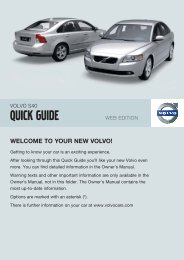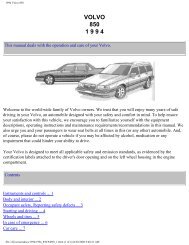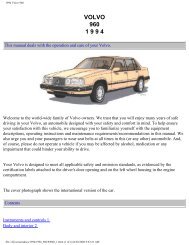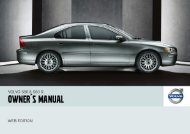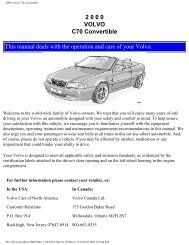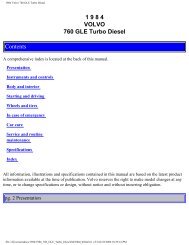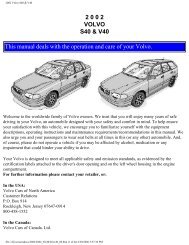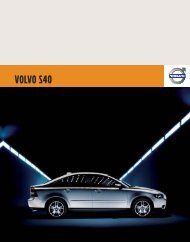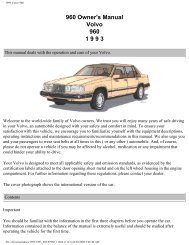V50 w646.book - ESD - Volvo
V50 w646.book - ESD - Volvo
V50 w646.book - ESD - Volvo
You also want an ePaper? Increase the reach of your titles
YUMPU automatically turns print PDFs into web optimized ePapers that Google loves.
07 Wheels and tyres<br />
Emergency puncture repair<br />
WARNING<br />
Never stand next to the tyre when the compressor<br />
is running. Be particularly observant<br />
of the tyre walls. If cracks, irregularities<br />
or other damage appears, turn off the compressor<br />
immediately. Under these circumstances<br />
your journey should not continue.<br />
Contact an authorised tyre centre.<br />
– Undo the air hose (4) from the air valve<br />
and put the dust cap back on. Unplug the<br />
lead (5) from the electrical socket. Fold the<br />
orange-coloured part (7) back into its original<br />
position and secure the catch (6).<br />
Keep the emergency repair kit in a safe<br />
place in the car.<br />
– Immediately drive about 3 km, at a maximum<br />
speed of 80 km/h, to allow the sealing<br />
fluid to seal the tyre well.<br />
WARNING<br />
You should not drive faster than 80 km/h<br />
after the emergency tyre repair kit has been<br />
used. The temporarily sealed tyre must be<br />
changed as soon as possible (maximum<br />
driving distance: 200 km).<br />
Check the tyre pressure again:<br />
NOTE<br />
Do not raise the orange-coloured part (7)<br />
when only the compressor is to be used for<br />
inflation.<br />
– Connect the air hose (4) to the air valve on<br />
the tyre. Connect the lead (5) to the 12 V<br />
power point. Read the pressure on the<br />
compressor. If the tyre pressure is below<br />
1.3 bar, the tyre has not been sufficiently<br />
well sealed. The journey should not be<br />
continued under these circumstances.<br />
Contact a tyre centre.<br />
– If the tyre pressure is higher than 1.3 bar,<br />
the tyre should be pumped up to the<br />
pressure stated on the tyre pressure label,<br />
see p. 158 for its location. Release pressure<br />
with the reduction valve (8) if the tyre<br />
pressure is too high.<br />
– Turn off the compressor; the switch (2)<br />
should be in position 0. Detach the air<br />
hose and unplug the lead. Replace the<br />
valve’s dust cap.<br />
– Put the lead (5) and air hose (4) into the<br />
side compartment (3).<br />
– Put the puncture repair kit back under the<br />
floor in the cargo area.<br />
IMPORTANT<br />
The compressor should not run for more<br />
than ten minutes at a time. Let it cool afterwards<br />
as there is a risk of overheating.<br />
NOTE<br />
The canister with sealant and hose should<br />
be replaced after use.<br />
07<br />
167



